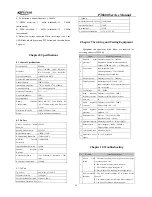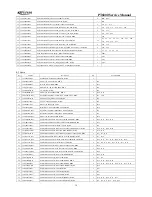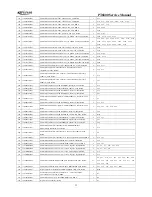
PT6800 Service Manual
12
39 201-006500-R06 Anode Bracket
1
40 204-006200-R04 Sponge Cushion
1
41 120-400000-R13 Flat Cable
1
42 301-20020G-R01 Machine Screw M2.0*2.0
4
43 203-006500-R07 Grounded Sheet
2
44 102-6800CN-R01 LCD Display Module
1
45 203-006500-R03 Keypad Metal Dome
1
46 202-006500-R06 Numeric Keypad
1
47 202-000558-R09 Waterproof MIC Cover
1
48 204-006800-R06 MIC Washer
1
49 204-006500-R01 Dustproof Washer for LCD Lens
1
50 201-006500-R08 LCD Lens
1
Chapter 7 Adjustment
7.1 Adjustment Method
After changing components during the maintenance, it is
necessary to test the radio and adjust its technical parameters.
7.1.1 Components required during adjustment
1) Antenna connector converter
2) Universal connector
7.1.2 Manual tuning method
1) Five frequency points of the radio need to be adjusted.
The following table is the frequencies corresponding to the
numeric keys.
Radio Model
Key 1
Key 2
Key 3
Key 4
Key 5
PT6800 (2) 350.05MHz 370.05MHz 389.95MHz 360.05MHz 380.05MHz
PT6800 (4) 400.05MHz 435.05MHz 469.95MHz 417.05MHz 452.05MHz
2) Panel tuning mode (Manual)
Press and hold “
” key while turning the radio power ON
to enter the panel tuning mode.
Press “
” key or “
” key to select the item you want to
adjust.
Press “
” key to save the adjusted parameters.
Press the “Redial Button” to switch between wideband and
narrowband.
Press key “7” to switch between “Emphasis” and
“De-emphasis”.
Press key “8” to enable or disable “Compander” function.
Press key “9” to enable or disable “Beat Shift” function.
Turn the rotary encoder to adjust the parameters of the radio.
Press key “1”, “2”, “3”, “4”, and “5” to choose the five
frequency points of the radio.
Items need to be adjusted and the tuning points under tuning
mode are listed in the following table:
Item
Display
Tuning Method
Tuning Point
Tx/Rx
Frequency
FREQUENCY
Rotary Encoder Center freq point Tx
High power
HIGH POWER
Rotary Encoder Five freq points
Tx
Low power
LOW POWER
Rotary Encoder Five freq points
Tx
DQT balance
DQT BALANCE Rotary Encoder Five freq points
Tx
Max deviation
MAX DEV
Rotary Encoder Five freq points
Tx
QT deviation
QT DEV
Rotary Encoder Five freq points
Tx
DQT deviation
DQT DEV
Rotary Encoder Five freq points
Tx
DTMF deviation DTMF DEV
Rotary Encoder Center freq point Tx
FFSK deviation
FFSK DEV
Rotary Encoder Center freq point Tx
Tone deviation
TONE DEV
Rotary Encoder Center freq point Tx
Battery detect
BATT
Rotary Encoder Center freq point Tx
Sensitivity
SENS
Rotary Encoder Five freq points
Rx
Squelch
SQL
Rotary Encoder Five freq points
Rx
RSSI (low)
LOW RSSI
Rotary Encoder Five freq points
Rx
RSSI (high)
HIGH RSSI
Rotary Encoder Five freq points
Rx
3) Parameter adjustment
Rx Part
Set the general test set and the radio, and make sure that the
test set is in its Rx interface, and the radio is in the Tuning
Mode.
1. Sensitivity: SENS
a) Set the signal strength of the general test set to be -119dBm
(wideband/narrowband), set its modulation signal to be 1kHz,
and the deviation to be
±3kHz (wideband), ±1.5kHz
(narrowband). Set the filter of the general test set to be in the
bandpass status.
b) Press “
” key or “
” key to select SENS in the radio.
Then turn the volume knob of the radio to make the output
audio power indicated in the general test set to be 500mW.
Then adjust the five frequency points.
c) Press key “1”, “2”, “3”, “4”, “5” respectively (corresponding
to the five frequency points of the radio), turn the rotary
encoder to make the SINAD indicated in the general test set to
be
≥
12dB. Then press “
” key to save.
2. Squelch: SQL CLOSE, SQL OPEN
a) Set the signal strength of the general test set to be -121dBm
(SQL OPEN)/-123dBm (SQL CLOSE), set its modulation
signal to be 1kHz, and the deviation to be ±3kHz (wideband),
±1.5kHz (narrowband). Set the filter of the general test set to be
in the bandpass status.
b) Press “
” key or “
” key to select SQL OPEN/SQL
CLOSE in the radio. Then turn the volume knob of the radio to
make the output audio power indicated in the general test set to
be 500mW.
c) Turn the rotary encoder. When the value displayed keeps
stable, press “
” key to save. (Press key “1”, “2”, “3”, “4”,
“5” respectively to adjust the five frequency points of “Low”,
“Lower”, “Mid”, “Higher”, and “High”)
Note: Press the “Redial Button” to switch between
wideband and narrowband.
Summary of Contents for PT6800
Page 28: ...PT6800 Service Manual 27 Figure 3 PT6800 Main Board Top Layer Position Mark Diagram ...
Page 29: ...PT6800 Service Manual 28 Figure 4 PT6800 Main Board Bottom Layer Position Mark Diagram ...
Page 30: ...PT6800 Service Manual 29 Figure 5 PT6800 Main Board Top Layer Position Value Diagram ...
Page 31: ...PT6800 Service Manual 30 Figure 6 PT6800 Main Board Bottom Layer Position Value Diagram ...
Page 33: ...PT6800 Service Manual 32 Figure 8 PT6800 Key Board Top Layer Position Mark Diagram ...
Page 34: ...PT6800 Service Manual 33 Figure 9 PT6800 Key Board Bottom Layer Position Mark Diagram ...
Page 35: ...PT6800 Service Manual 34 Figure 10 PT6800 Key Board Top Layer Position Value Diagram ...
Page 36: ...PT6800 Service Manual 35 Figure 11 PT6800 Key Board Bottom Layer Position Value Diagram ...
Page 40: ...PT6800 Service Manual 39 Figure 16 KBC 60Q Schematic Circuit Diagram ...
Page 41: ...PT6800 Service Manual 40 Figure 17 PCB Layout 1 ...
Page 42: ...PT6800 Service Manual 41 Figure 18 PCB Layout 2 ...




























